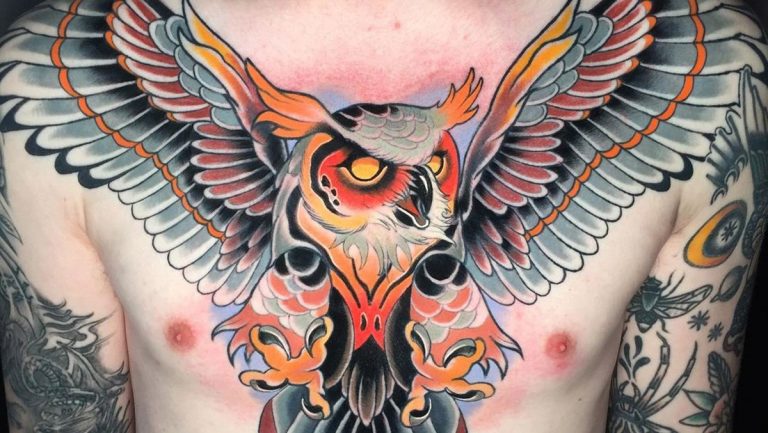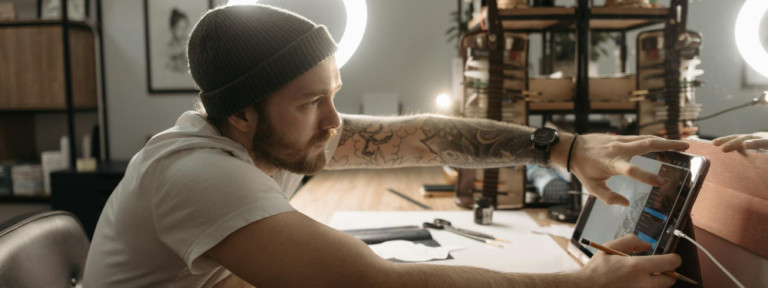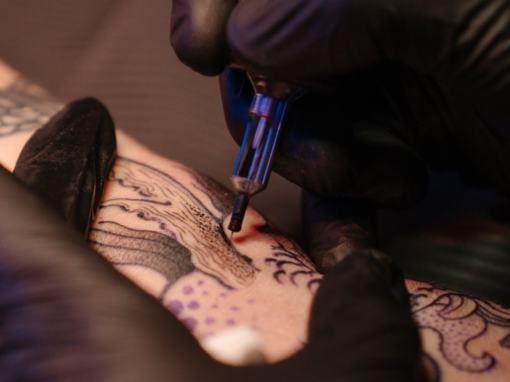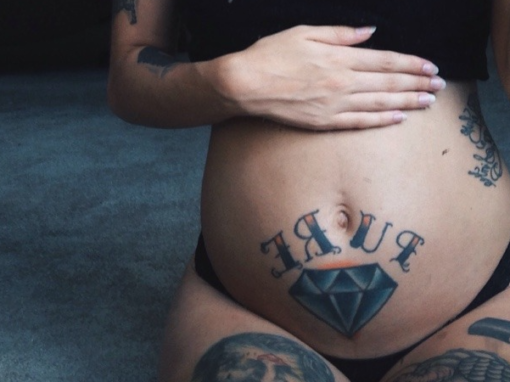Have you poured your heart and soul into creating incredible tattoo designs, but don’t know how to turn them into a fruitful business? Or do you frequently hear that your artwork is more deserving of respect than to be forgotten in albums? You’re not alone! In this comprehensive guide, you’ll find everything you need to know about how to sell tattoo designs online and offline and succeed.
We’ve broken everything down into clear steps, from what skills you’ll need, what types of sales resources exist, and how to price your work, to navigating exciting and helpful online and offline marketing strategies. Let’s get started and dive in, learn new things, and discover the answers to the most important questions!
Essentials for Selling Tattoo Designs
If you have a passion for creating fantastic tattoo designs, congratulations: you’re already halfway to selling your work. We’ll give you some advice on how to prepare for this, so you’ll be confident in yourself, your abilities, and what you’ll need.

Skills and Supplies
This isn’t an exhaustive list, but it’s a solid foundation of skills and supplies that both seasoned artists and those who just started their journey will need. The good news is, you don’t necessarily need a fancy tattoo machine to get started.
- Strong drawing fundamentals are key. Practice anatomy, shading, and composition to create designs that translate well onto the body.
- Many tattoo artists utilize graphic design tools to create clean, adaptable designs. If you haven’t tried it yet, you should learn how to do it.
- Designing a tattoo online is good, but traditional tools never go out of style. Pen and paper are great for sketching ideas and developing your unique artistic style, so learn how to draw tattoos on paper.
Building Your Portfolio
Now that you’re armed with some artistic firepower, it’s time to build a portfolio that grabs attention. Think of it as your artistic resume, where potential clients can see your range, style, and expertise.

Reason №1
It allows people to see the quality of your work, the level of detail you can achieve, and the range of styles you excel at.
Reason №2
A well-curated portfolio demonstrates your professionalism and dedication to your craft.
Reason №3
A strong portfolio can spark inspiration in potential clients. They might see a design they love and request a variation of it, or use your portfolio as a springboard to discuss their unique ideas.
Reason №4
Your portfolio might catch the eye of tattoo shops or studios looking for talented artists to collaborate with.
3 Ways of Selling Tattoo Designs Online
Here you’ve honed your skills and built a brilliant portfolio, it’s time to show the world your designs. The beauty of the digital age is the abundance of online platforms to connect with potential clients. Here are three fantastic ways to turn your artistic passion into profitable sales.

Art Design Sites
Some websites like Inprnt, Redbubble, and Creative Market are dedicated to artistic design and are specifically geared towards tattoo enthusiasts. On these platforms, you can upload your artwork, set prices, and connect with tattoo artists and collectors who are looking for unique designs.
This is a great option for beginners looking to put their work out there and create a name for themselves.
Pros
- Art design websites are geared toward tattoo enthusiasts, creative people, and those looking for tattoo designs
- A wide range of potential clients have a high chance of seeing and choosing your designs on these platforms
- User-friendly setup
- There is potential for passive income, so you can focus more on new tattoo designs
Cons
- Less control over how your designs are presented and marketed
- Lots of other artists, so a lot of competition
- Some platforms might restrict your ability to offer customization options like exclusive rights or modifications for the buyer
- Commission on sales
Social Media Powerhouse
Social media platforms like Instagram and Facebook are powerful tools for any artist. They allow you to directly connect with clients and tattoo shops around the world. Here’s where you can build a community and establish yourself as a brand.
While social media isn’t a traditional online store, you can still use it directly to sell your tattoo designs. For example, you can post a collection of tattoo designs and write the price of each design in the post description.
Post high-quality images of your designs.
Showcase your range and highlight the details that make your work stand out.
Engage with your audience, respond to comments, answer questions, and participate in tattoo-related discussions.
Run targeted ads or collaborate with tattoo influencers.
Pros
- You can directly interact with interested people
- Free to use
- Social media is image-driven, which allows you to present your designs in a visually appealing way
- Brand recognition through constant posting and engagement
- You can reach people specifically looking for tattoo designs
Cons
- Limited sales functionality
- Algorithm dependency
- There’s a risk of someone stealing your design and using it without permission
- While you can generate interest, converting viewers into paying customers can be challenging on social media alone
A Professional Website
To maximize control and build your brand, consider building a professional website. This is your dedicated online space to showcase your portfolio and communicate directly with clients.
The beauty of this is that you choose the look, feel, and functionality of your website. Including clear pricing information, contact details, and a secure payment gateway for seamless transactions.
Pros
- You have complete control over your brand and artwork
- You can set up a secure payment gateway for clients to purchase your designs directly
- Detailed information about you and your work for clients
- A well-designed website portrays a professional image and builds trust
- Enhanced control over ownership rights
Cons
- Building and maintaining a professional website can involve significant costs
- Attracting traffic to your website requires marketing efforts like social media promotion, search engine optimization (SEO), or paid advertising
- You should keep your website secure, updated, and functioning smoothly
- Many tattoo artists have websites, so standing out and attracting clients requires high-quality designs and effective marketing
4 Ways of Selling Tattoo Designs Offline
Yes, you may think it’s strange in the age of digitalization, but don’t underestimate the power of the physical world! While online platforms offer a huge reach, there’s something special about face-to-face interactions with people.
? Here are four ways to showcase and sell your tattoo designs offline:
A classic approach is visiting local tattoo studios and shops. Offer them a chance to purchase exclusive rights to use your designs for their clients, or strike a deal where they receive a commission for each tattoo done using your artwork.
Tattoo conventions and art expos are fantastic opportunities to showcase your work. Network with industry professionals, and connect with potential clients. These events often attract serious tattoo enthusiasts and collectors actively seeking unique designs.
Also, consider showcasing your work at local art markets, street fairs, or community events. These events can attract a wider audience who might not have been actively searching for tattoo designs but could be captivated by your artwork and its potential as a tattoo. Offer smaller, more affordable options like flash sheets (pre-drawn designs) alongside your portfolio.
You can partner with local artists or businesses that cater to a clientele interested in tattoos. For example, collaborate with a piercing studio or a clothing brand that aligns with your artistic style.
Pros
- Personal connection with clients
- attoo studios, conventions, and art markets attract relevant audiences already interested in tattoos
- Offline selling allows you to showcase your work uniquely and memorably
- Immediate sales
- Offline interactions allow you to network with tattoo industry professionals, potentially leading to long-term partnerships and growth opportunities
Cons
- Offline methods typically reach a smaller audience compared to online platforms
- Geographic limitations
- Investment of time and resources
- When partnering with shops or studios, you might have less control over pricing or how your designs are presented
- Tattoo conventions and art markets can be crowded with other artists
Setting a Price for Your Work
After going through all of the above stages, the question comes: how much should you charge? Getting money for tattoo designs can feel daunting, especially if you’re new to the industry. Yet we’re ready to share the tips you need to confidently determine rates and secure your success as a tattoo designer.

? There are several key factors to consider when pricing your tattoo designs:
✅ Time and complexity of your work
The more intricate and detailed your design, the longer it will take to create. Factor in the estimated time it takes to draw the design, including revisions, into your pricing structure.
✅ Experience and reputation
As you gain experience and build a reputation for high-quality work, you can gradually increase your prices.
✅ Client budget and location
Be realistic about your target market. Research what other tattoo artists in your area charge for similar styles and designs. Consider offering a pricing range to accommodate different client budgets.
✅ Licensing vs. selling ownership
Will you be selling the exclusive rights to your design, or granting a license for one-time use? Exclusive ownership generally commands a higher price.
? Pitfalls to avoid:
❌ Undervaluing your work
Don’t shortchange yourself. Factor in the time, effort, and skill that goes into creating your designs. Remember, you’re a professional artist, and your work deserves fair compensation.
❌ Price wars
Resist the urge to undercut other artists in your area. Focus on the value you bring, the uniqueness of your style, and build your brand accordingly.
❌ Not considering hidden costs
Factor in any additional costs associated with selling your designs, such as printing fees for flash sheets or website maintenance expenses.
Start with a competitive baseline and adjust as you grow.
Offer package deals for larger or multi-session tattoo designs.
Consider a deposit system to secure serious clients.
Marketing and Promotion — Getting Your Designs Seen
So you’ve got the talent, the drive, and the business savvy –– fantastic! Now it’s time to get your amazing tattoo designs out there and into the hands (or should we say, onto the skin) of eager clients. Here are some effective marketing and promotional strategies to supercharge your visibility:

? Social media activity
Utilize the power of platforms like Instagram, Facebook, TikTok, and even YouTube to showcase your work. Run targeted ads, collaborate with tattoo influencers, and participate in relevant online communities to build a dedicated following.
? Hashtag hero
Research popular tattoo hashtags and incorporate relevant ones into your posts to ensure your work is discoverable by potential clients searching for specific styles.
✍️ Content is king
Create engaging content beyond just static images. Share timelapse videos of your design process, offer design tutorials, or collaborate with other artists on guest posts.
? Collaborations and cross-promotion
Partner with other creatives whose audience might be interested in tattoos. This could be a local piercing studio, a clothing brand with an edgy aesthetic, or even a photographer specializing in body art. Cross-promotion allows you to tap into a new audience and potentially spark exciting creative collaborations.
⚡ Freebies and flash sales
Strategically using freebies and flash sales can help raise attention and attract new customers. Offer a limited-edition flash sheet at a discounted rate, tattoo patterns for sale, or hold a contest in which the winner receives a tattoo from your portfolio.
? Get featured
Submit your work to online tattoo design galleries or relevant publications. Being featured on a reputable platform can increase your visibility and establish you as a rising talent.
Summary
Sure, while all these steps and strategies listed above may appear intimidating at first, however, there is a path to success for both beginners and seasoned artists. You will establish yourself as a competent artist by focusing on your technique, properly displaying your drawings, and understanding how they transfer to the body. This, in turn, will attract clients who want to work with you and wear your creations on their skin.
This post covered the different online and offline platforms you may utilize to sell your tattoo designs, along with advice on how to market them effectively.
As we mentioned from the beginning, selling your works is just as important as being able to draw them. The knowledge of how to do it is the other half, which you now possess. We hope your business grows and that you have good sales!
FAQ
? Do I Need To Be a Tattoo Artist To Sell Tattoo Designs?
Not necessarily. Great design is what matters. But understanding tattooing helps. Knowing how to draw tattoo art, what translates well to skin, size limitations, and popular styles can give your designs an edge.
? How Should I Price My Tattoo Designs?
There’s no one-size-fits-all answer. Consider the complexity of the design, the time it takes to draw, and your experience. Investigate what other artists charge for similar work, and follow the advice we provided above.
? How Much Can I Expect To Earn From Selling Tattoo Designs?
It depends on the situation. Some sell for a few bucks, while complex designs can fetch hundreds
?️ What Are the Most Popular Tattoo Design Styles That Sell Well?
Trends change, but some styles consistently sell well. Black-and-gray realism, traditional, and illustrative styles are popular. Also, don’t forget the timeless appeal of easy-to-draw designs.
? Do I Need to Copyright My Tattoo Designs?
Yes, it’s a good idea to copyright your tattoo designs and protect your ownership rights. Copyrighting your designs can help prevent others from using or reproducing them without your permission. It’s an important step to safeguard your creativity and potential income.
? Can I Sell the Same Design Multiple Times?
It is at your discretion, but you should warn about it right away. Usually, you can see that tattoo designs are made to order, or after buying the work, the artist removes it from the available. There is also the option of selling tattoo patterns, they can usually be sold many times, but this should also be indicated in your account, or personally to the buyer.





